
+- WildFact (https://wildfact.com/forum)
+-- Forum: Information Section (https://wildfact.com/forum/forum-information-section)
+--- Forum: Captive & Domesticated Animals (https://wildfact.com/forum/forum-captive-domesticated-animals)
+--- Thread: Captive Lion and Tiger weights (/topic-captive-lion-and-tiger-weights)
RE: Captive Lion and Tiger weights - Kingtheropod - 11-02-2016
NIKITA Male Siberian Tiger DOB 8/20/95 – DOD 1/22/15 Rescued 10/21/07 Nakita is a large tiger weighing in at nearly 600 pounds at his prime. He had been raised with Simba, Joseph, and Sasha and the four shared an enclosure prior to coming to Big Cat Rescue. When the group initially arrived

*This image is copyright of its original author
Him below
[video=dailymotion]https://www.youtube.com/watch?v=zJV1Kdz85dU[/video]
https://bigcatrescue.org/tag/siberian-tigers/
RE: Captive Lion and Tiger weights - Kingtheropod - 11-02-2016

*This image is copyright of its original author
When you drive off the I-10 in Grosse Tête, Louisiana, you'll run into a roadside attraction at the Tiger Truck Stop. No, not a giant statue or an object declaring itself to be the "World's Largest," but a live 550-pound Siberian tiger named Tony. The 14-year-old animal has lived near the gas station in a 12-by-24-metre enclosure his whole life.
Animal rights groups have been trying to free Tony for years, but his owner, Michael Sandlin, has succeeded in challenging local laws that would remove the tiger from his gas station. The battle between Mr. Sandlin and animal rights groups has been acrimonious to say the least.
"The animal rights organizations we do believe are domestic terrorists in nature," Mr. Sandlin tells As It Happens guest host Susan Bonner. "They're anti-caging, anti-circus, anti-rodeo, anti-animal agriculture, you know, they spend every dollar they take in to further the agenda to disrupt every animal industry in the country... it's actually trying to exalt animal rights over human rights and we don't agree with that kind of extremism."
Mr. Sandlin also keeps signs at the Tiger Truck Stop that denounce "the evils of animal rights."
"My dad purchased him from a breeder in Texas and I acquired Tony when he was six months old and brought him to Grosse Tête," Mr. Sandlin says. "He's been here 14 years, but there's been tigers in the exhibit for 26 years."
http://www.cbc.ca/radio/asithappens/monday-israeli-teenagers-scotus-contraception-ruling-doig-auction-and-more-1.2903409/the-battle-over-tony-the-gas-station-tiger-the-louisiana-roadside-animal-attraction-1.2903410
RE: Captive Lion and Tiger weights - Pckts - 11-03-2016
Topeka Zoo
Avus, our male lion, recently weighed in at 364 pounds! This picture shows Avus receiving a treat of meat from Zookeeper Drew after he completed his training and stood still on the scale in his lion area, so they could get his weight.

*This image is copyright of its original author

*This image is copyright of its original author
RE: Captive Lion and Tiger weights - GrizzlyClaws - 11-03-2016
It could be an Ethiopian lion, since they don't get particularly large most of time.
RE: Captive Lion and Tiger weights - Pckts - 11-03-2016
(11-03-2016, 01:27 AM)GrizzlyClaws Wrote: It could be an Ethiopian lion, since they don't get particularly large most of time.
The website just says african lions, could be ethopian but I wouldn't bet on it.
"Lions Pride
Visit Avus, Asante and Zuri in a unique exhibit with three viewing options.
African Lions"
Topeka Zoo
Happy #caturday from Avus the African lion!

*This image is copyright of its original author
He's just a smaller lion I think, from the weights posted on this thread and the captive cats thread, lions seem to run the same size range as tigers in captivity. (with exceptions of course)
RE: Captive Lion and Tiger weights - Pckts - 11-03-2016
Yorkshire Wildlife Park
May 28, 2012 ·
An endangered tiger’s tooth operation sparked an emergency when her heart stopped during a dental operation.
Amur tiger Sayan was having a routine root canal filling when she suffered a rare reaction and had a cardiac arrest two hours into the procedure.
Vets at Yorkshire Wildlife Park immediately noticed 3 year-old Sayan’s vital signs were deteriorating. They gave heart massage and TWO shots of adrenaline to bring her back to life.
Vet Alan Tevendale, 31, said: "We noticed a change two hours into the operation and found no pulse or heart beat.
“We then immediately started cardiac massage and gave a shot of intravenous adrenaline. When this didn't work we had to give another shot of adrenaline directly into the heart whilst we continued cardiac massage.
“When I checked again she had a pulse and heartbeat. Gradually, she returned to a steady rhythm. After five minutes we took her off ventilation and she managed to breathe herself.
“This is very rare and was extremely stressful – the most stressful experience of my life. We are all so relieved she is now ok”
Sayan, who weighs around 160 kilos, had been acting grumpily and keepers at YWP, which is one of a handful of wildlife parks to have an on-call animal dentist, decided to get her teeth examined in case they were causing her discomfort.
A specialist dentist was called in to examine the tiger’s teeth. After a full check up he opted to perform a root canal filling to a lower canine.
But the operation which should have been straightforward took a dramatic twist last week.
“There is always a risk with anaesthetics but I have not seen this reaction in a tiger in 27 years and I have worked on hundreds of big cats.,” said dentist Peter Kertesz, who has a practice in Central London.“The good thing is that we had the expertise to cope with the emergency and, although her heart stopped for seven to ten minutes, Sayan was in good hands and she has made a great recovery.”
Sayan came to YWP in Branton near Doncaster to live in Land of the Tigers last year as part of the Amur Tiger Breeding Programme. Fewer than 400 Amur Siberian tigers are left in the wild because of habitat loss and poachers.
She had been kept in a separate but adjacent enclosure to 3 year-old male Vladimir for eight months while they got acclimatised to each other before being introduced on Valentine’s Day.
Yorkshire Wildlife Park Cheryl Williams said: "We are extremely grateful for the expertise and speed of the whole medical team.
“They were brilliant in bringing Sayan back to life."
"The welfare of our animals is our highest priority and I am delighted to report that Sayan is now back in the Land of The Tigers and seems much better tempered!”
The spectacular Land of The Tigers os one of the largest and most innovative tiger enclosures in Europe – with two pools, a waterfall and a stunning 150m walkway for visitors.
YWP is working with the studbook keeper for Amur Tiger European Breeding Programme, which aims to save the tiger from extinction
Sayan was allocated to YWP from the programme, which manages the movements of tigers and their breeding, selecting partners for their suitability and genetic diversity at zoos around Europe.
YWP hopes to welcome another pair of tigers soon as part of the European Breeding Programme. The tigers will live as pairs, as unlike lions, they are not a social cat that lives in large groups.
It is hoped in the future the tigers will make their own contribution to the programme, but any breeding is subject to the recommendation from the studbook keeper.
An old but gold photo of Sayan! #Caturday
Photo Credit: Dave Hunt

*This image is copyright of its original author
That's a big girl, 160kg at 3 years old.
Mt. Spokane Veterinary Hospital
A white Bengal tiger under anesthesia for a radiograph here at Mt. Spokane! This tiger weighs a little over 500 pounds and has been experiencing a limp for a couple days.

*This image is copyright of its original author
Debbie Blackwell Is she from Cat Tails? Glad you all are there to fix all "Gods Creatures, great and small"!
May 13, 2013 at 5:03pm · Like

*This image is copyright of its original author
Mt. Spokane Veterinary Hospital Yes, this tiger is from cat tales! We love helping every animal that comes our way.
It may be a female but I doubt it at that size.
COPAL
THE TIGER WHO FLEW HALFWAY ACROSS THE WORLD FOR A BETTER LIFE..!
(He weighs 260kg, has a bone-crushing bite and paws the size of dinner plates, but Phevos the tiger is the latest victim of Greece's economic crisis - and this week he left the country for a new home on other side of the world.)
Most of the time Phevos is a gentle creature. I sat with him the day before his journey, and he was quiet, content and passive.
"He reacts very well to being softly spoken to. He listens when I talk to him. He twitches his ears, and he loves having his head rubbed," says David Barnes, a former RSPCA inspector.
Barnes has spent the past year arranging to rescue Phevos from a small zoo in Trikala, central Greece, which has struggled to look after its exotic animals in the face of the cuts which have hit every aspect of Greek life.
"But he is a tiger. I've seen him turn - he did it the other day - when he sees someone he doesn't like. That tells me straight away, something bad happened there. He's very, very, clever."
Barnes talks to Phevos continuously. The 41 stone (573lb) tiger knows and recognises human faces and reacts positively to people he trusts.
The zoo used to have a resident vet but it couldn't afford to employ her. She is still consulted occasionally but there is no longer constant veterinary care.
For a long time, Barnes was also worried that some animals weren't getting the right food. Then in March the other tiger at Trikala, Athena, died from complications brought on by a badly infected paw.
"It was neglect," says Barnes. "Pure and simple. If that had happened in Britain there would have been prosecutions without a shadow of a doubt. It took four months just to get permission from the Greek government to anaesthetise her. That's crazy."
Until his departure from Greece, Phevos - who is part Bengal tiger and part Siberian - was actually owned by the Greek government.
The new home for Phevos is the Lions, Tigers and Bears Sanctuary in Alpine, California. He'll be with other tigers there, and will get the veterinary attention he needs for hip dysplasia - a congenital problem which causes pain when he walks.
It probably stems from interbreeding in the travelling circus where he began his life. Barnes rescued him from the circus 13 years ago so this is the second time he has intervened to improve his quality of life.
For Barnes, the main hurdle in this whole process has been less to do with the practical challenges of shipping a large tiger, and more about finding a route through the maze of bureaucracy.
"Around every corner there was something blocking the way," he says. "It took eight months to sort out the paperwork. I've been emailing, texting, and telephoning. There've been times when I've thought it's not going to happen. But once I'd decided I was going to do it, I had to do it. I had to carry it through."
It took extensive negotiation with the Greek and US governments, as well as the local authorities in Trikala. Special permits had to be obtained under CITES (The Convention on International Trade in Endangered Species) because there are only about 3,000 tigers left in the wild.
A last minute hitch emerged a couple of hours before departure, when a new demand came from the shipping agents that under IATA (International Air Transport Association) regulations each air hole in Phevos's crate had to be 5cm wide. A carpenter was rushed to the zoo, so some holes could be widened.
"Then we had to deal with customs and the veterinary authorities for health certificates - he's been vaccinated, micro-chipped, and he's been blood-tested. But the longest wait wasn't Greece. It was the American authorities for the import licence," says Barnes.
"From what I understand, the USA does not actively encourage the importation of big cats because they think they've got enough in the USA. The sanctuary he's going to has never brought an animal in from outside the country before."
Then getting Phevos into the crate was another challenge. Even the sight of his favourite meal - a chicken (he eats 35 a week) - failed to tempt him in. Eventually after 30 minutes of failed coaxing, a vet tranquilized him and he was dragged in by ropes attached to his paws, after which he was woken up again.
Before dawn on Wednesday, the crate was hoisted into the air by crane and deposited in a truck which took him from Trikala to Athens. Barnes and I followed in our car as the sun rose over the mountains of central Greece - Phevos, which means Sun God, made his way towards the airport and a new life.
In Trikala there are complex emotions about losing Phevos.
"We're feeling strange today," says Odisseas Raptis who runs e-Trikala, part of the municipal government which owns the zoo.
"I don't know if we are happy or we are sad. First of all we are happy that Phevos is going to a better place to live the rest of his life in peace and better conditions.
"But on the other hand we're sad because we are used to having tigers here in Trikala. Honestly speaking, overall we're feeling sad," he says.
He admits that the animals at the zoo should have been looked after better.
"There's been a lack of money for years and we haven't had enough specialist knowledge of how to treat these exotic animals. Of course we are not happy that animals have suffered here, but we've always wanted the best for them. That's why we are sending him to the US."
And it seems Phevos may not be the only one on the move - Barnes says his next task is to get some of the other animals at the zoo rehoused.
His wish list includes a female Coati Mundi - a member of the raccoon family from South America, a male wallaby, a male Skyros pony and some miniature zebu. Almost all these animals are alone because their companions have died.
After a six-hour drive we arrived at Athens Airport, and word quickly went around among the cargo staff that they had an unusual traveller in their midst. Crowds of handlers - people well used to shipping goods across the world - milled around the crate taking photographs and peering through the air holes. Inside the crate Phevos appeared to be unfazed, despite the noise, excitement, and moving vehicles of a busy loading bay.
Staff fixed extra labels to the crate saying "Attention. This Animal Bites."
A few hours later Phevos was loaded onto a Boeing 767, into a pressurised section at the front of the aircraft hold, for the first leg of the flight - to London Heathrow.
The novelty factor was also apparent when we boarded the plane. Word went round among the passengers that there was a tiger on board. One of the stewards told me they'd all watched the crate being loaded. "I've never flown with a tiger before," one of them said. "It's really exciting."
After spending the night in quarantine at Heathrow, Phevos continued his journey on Thursday to San Diego, California.
Barnes was there every step of the way. "I've rescued many animals before… but this is by far the biggest thing I've ever done on my own. I'm proud of what I've achieved," he says. "I've made a lot of friends in Trikala and in Greece over the years and I'm really grateful that everyone has been so helpful.
"He's going to a better life - that's what it's all about."
By Andrew Bomford
BBC News
source: http://www.bbc.com/

*This image is copyright of its original author
RE: Captive Lion and Tiger weights - Pckts - 11-03-2016

*This image is copyright of its original author
"Guess the weight of Rocky"
208kg Amur Tiger weight is at 7:50 "Weight Expectations:
Just before going into Tamair's new enclosure, we weighed Tamair in his crate. With the crate we had a weight of 389KGs (855lbs, 61 stone 1lb). Taking the weight of the crate off, Tamair weighed 208KGs (457.6lbs, 32 stone 9lbs).This is about average for a male Siberian Tiger."
Two lions underwent dental surgery Friday after being rescued from Peruvian circuses, where they were kept in appalling conditions.
The big cats — named King and Simba — were among 21 lions saved last year by members of Los Angeles-based Animal Defenders International.
“In the circuses, they often break their teeth and remove their claws,” said Eva Chomba, a Peruvian veterinarian with Animal Defenders.
“It’s a painful process in which they do not use anesthesia and those doing it are not veterinarians.”
King was unable to chew normally because most of his teeth had been pulled by the circus owners. Simba’s front claws had been removed and his fangs broken.
A team of veterinarians sedated the pair of lions — which weigh more than 352 pounds and are 17 and 7 years old, respectively — to perform dental surgery.

*This image is copyright of its original author
*This image is copyright of its original author

*This image is copyright of its original author
*This image is copyright of its original author
http://www.nydailynews.com/news/world/li...-1.2123948
Same lions, with a little more detail.

*This image is copyright of its original author
*This image is copyright of its original author
http://www.dailymail.co.uk/wires/ap/arti...fixed.html
Different Lion
AL AIN // When your lions have toothache, whom do you call?
Al Ain Zoo recently found itself wrestling with this painful question and found the answer in Dr Gerhard Steenkamp, a specialist from South Africa.
A 113kg tawny lion, believed to be less than two years old, and his sister from the same pride were rescued by the Ministry of Water and Environment last month.

*This image is copyright of its original author
*This image is copyright of its original author
Video in the link below
http://www.thenational.ae/uae/al-ain-zoo...ions-teeth
No info on this boy, but check him out

*This image is copyright of its original author
*This image is copyright of its original author
Possibly the same lion?
"Recently Perth Zoo keepers noticed a lump on the back of 10-year-old lion Mandela. To investigate the lump, the big cat underwent a general anaesthetic at the Perth Zoo Veterinary Department on 8 August.
An ultrasound examination of the lump revealed it wasn’t filled with fluid. X-rays showed it was mineralised which explained its hardness. The x-ray and ultrasound findings suggested to veterinarians that they weren’t dealing with a malignant tumour but the only way to be sure was to do a biopsy. This involved surgically removing a tissue sample from the lump which was then submitted for analysis.
The results showed the lump was the product of an inflammatory reaction, most likely caused by a knock or injury. Over time, the lump should subside and it will not cause any problems for Mandela’s health.
Lumps and bumps in lions are not uncommon, as is the case with domestic cats and dogs. Unlike cats and dogs, however, it is impossible to do a thorough examination on a ferocious lion without the lion undergoing a general anaesthetic.
Moving a 184 kg lion is not something Perth Zoo staff do lightly so while Mandela was anaesthetised they also used the opportunity to check his general health. Blood samples were taken and he was screened for various infectious diseases with the test results coming back clear. He was also given his yearly vaccination using the same vaccine as domestic cats receive when they visit the vet.
After the examination, Mandela was returned to his exhibit where he recovered and rejoined his pride mates, Nelson and Shinyanga."

*This image is copyright of its original author
*This image is copyright of its original author

*This image is copyright of its original author
*This image is copyright of its original author

*This image is copyright of its original author
*This image is copyright of its original author

*This image is copyright of its original author
*This image is copyright of its original author

*This image is copyright of its original author
*This image is copyright of its original author
http://perthzoo.wa.gov.au/a-lumpy-lions-...tal-10350/

*This image is copyright of its original author
RE: Captive Lion and Tiger weights - Pckts - 11-03-2016
BigCat Rescue animal Weights
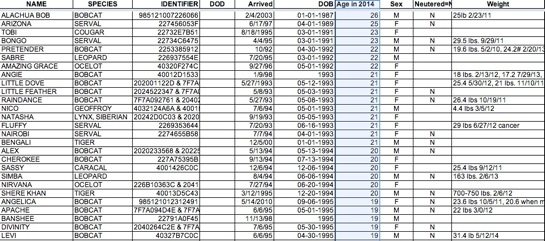
*This image is copyright of its original author
*This image is copyright of its original author
Check out this monster known as Shere Khan
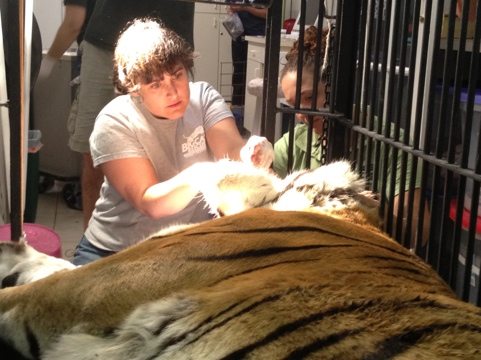
*This image is copyright of its original author
*This image is copyright of its original author
Shere Khan is probably one of our best known and most loved animals. It is a toss up as to who is bigger, Shere Khan or Nikita the tiger, but his heart is so big that it is legendary.
Today Dr. Wynn stitched up a scrape on his leg and removed a tumor that was growing under his tongue that was about the size of a grape. It is a testament to the amazing observation skills of our Keepers that so many noticed it. It was UNDER his tongue!
We will send it out for testing and drew blood for other studies, gave him a micro chip and his vaccinations and he should be fine to release back into his Cat-a-tat tomorrow.
He did not wake up fully enough to keep his new stitches dry in this heavy rain, so he is waking up in the Cat Hospital.
Nik the tiger has been moved to the Shere Khan and China Doll side and China Doll has been moved to Nik’s side in the hopes that more space for this duo will stop the agitation they have at seeing Nikita. Volunteers have hung three layers of shade cloth, but they still do their best to see each other across the long, wide hallway that separates the 3 ac enclosure from the 1 ac one.
He seems to be waking up well, breathing well and we hope he will be ready to move back outside tomorrow morning
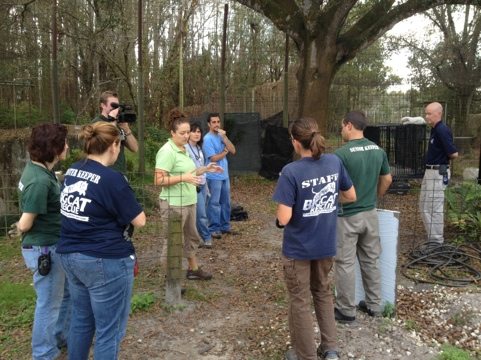
*This image is copyright of its original author
*This image is copyright of its original author
Shere Khan weighed more than 700 lbs w/ head, legs and tail off scale
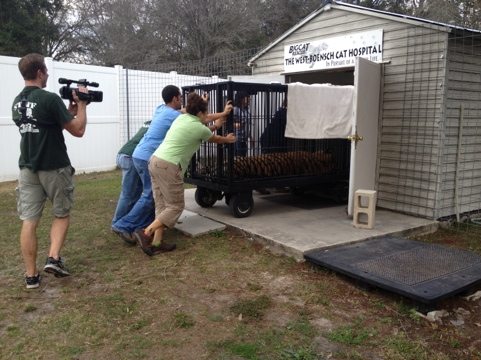
*This image is copyright of its original author
*This image is copyright of its original author
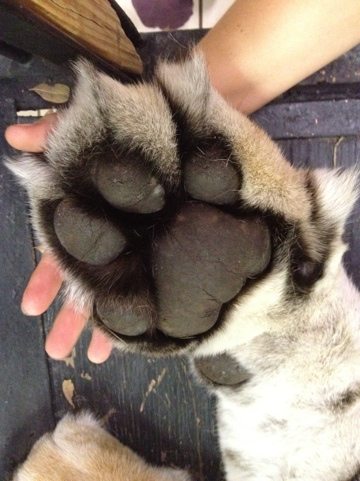
*This image is copyright of its original author
*This image is copyright of its original author
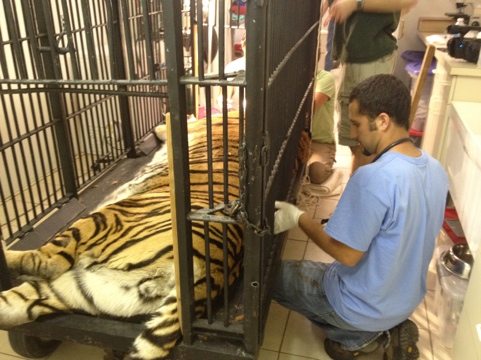
*This image is copyright of its original author
*This image is copyright of its original author
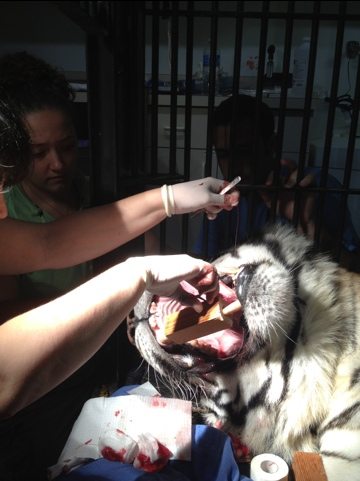
*This image is copyright of its original author
*This image is copyright of its original author
http://bigcatrescue.org/today-at-big-cat-rescue-feb-6/
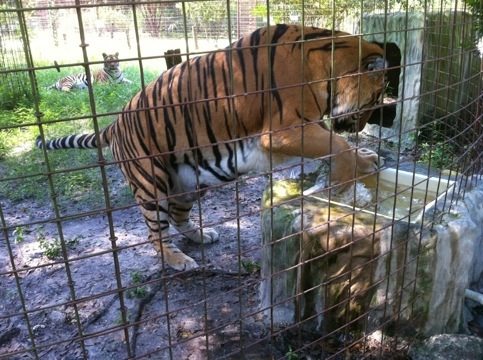
*This image is copyright of its original author
*This image is copyright of its original author
and here is Nikita said to be just as large as Shere Khan

*This image is copyright of its original author
*This image is copyright of its original author
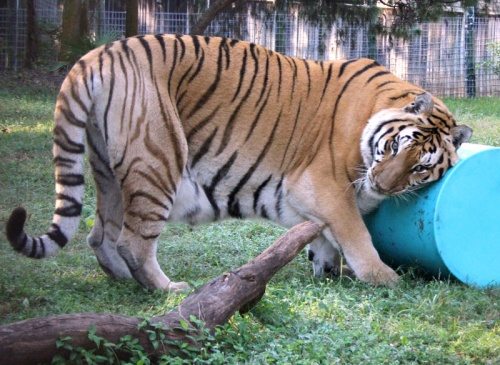
*This image is copyright of its original author
When life is good, Tunya, a 435-pound lion at the San Francisco Zoo, has sex 20 times a day and gets treats like "blood popsicles" or dead rabbits.
When life is bad, he shakes and trembles. Technically speaking, Tunya is a wobbler -- he sometimes has trouble putting weight on his front legs, and endures pain that can last for days.
On Thursday, vets at the zoo sent Tunya to the Veterinary Medical Teaching Hospital at UC Davis. The diagnosis: a cervical vertebral abnormality. The conclusion: no easy fix. The next step: unclear, but possibly another commute on Interstate 80 for high-risk surgery that might or might not cure his ills.
Tunya's rare troubles began about a year and a half ago. Zoo officials have observed two more shaking episodes since then, the most recent three weeks ago.
Dr. Freeland Dunker, head vet at the zoo, concluded that the area between Tunya's sixth and seventh vertebrae was skewed, resulting in a pinched nerve, and that surgery was the answer.
And so, at 5 a.m., Tunya and six zoo employees left for UC Davis, a world mecca
medicine.
It was the first time the zoo had brought an animal to Davis for surgery, Dunker said -- though it was not the first lion for Davis. And it was Tunya's first excursion since April 1997, when he arrived from South Africa, with much fanfare, at the age of 3 months.

*This image is copyright of its original author
*This image is copyright of its original author
http://www.sfgate.com/news/article/A-lio...750776.php
"In the circuses they often break their teeth and remove their claws," said Eva Chomba, a Peruvian veterinarian with Animal Defenders. "It's a painful process in which they do not use anesthesia and those doing it are not veterinarians."
On Friday, a team of veterinarians sedated King and Simba to perform dental surgery on the big cats, which weigh more than 160 kilograms (352 pounds) and are 17 and 7 years old, respectively.
U.S. veterinarian Peter Emily, founder of the Peter Emily International Veterinary Dental Foundation, said a previous oral surgery on King had created a small hole between his mouth and nose that had become badly infected.
The veterinarians determined King requires more surgeries and the lion will be taken to an animal sanctuary in Denver, Colorado, in the coming months, Peruvian veterinarian Jorge Hun said.
On Saturday, the veterinarians will look at the teeth of 26 monkeys also rescued from circuses.
Peru banned the use of wild animals in circuses in 2011, but implementation of the law has been slow."
___
Associated Press writers Mauricio Munoz and Martin Mejia contributed to this report.
http://www.sandiegouniontribune.com/news...get-their/
Veterinarians Perform Tooth Extraction on 408-Pound Lion
The 13-year-old lion was suffering from a dental infection and two cracked teeth.
By Cari Jorgensen
4
Published: 2016.02.25 11:15 AM

*This image is copyright of its original author
*This image is copyright of its original author
Mandela the lion’s trip to the dentist.
Perth Zoo/Facebook
During a veterinary exam at Perth Zoo in Australia, 13-year-old Mandela, a 408-pound lion, was found to have a dental infection and a couple of cracked teeth, UPI reports. Veterinary specialists were called in for the extraction.
Simone Vitali BSc, BVMS, PhD, MACVS (Zoo Animal Medicine) and Senior Veterinarian at Perth Zoo told the Australian Broadcasting Corporation, “Often predators in captivity give you very little in the way of clinical signs, so we didn't even know that Mandela had a dental infection until we anaesthetized him and had a look. It's quite amazing the sort of things they will tolerate. A tooth infection for us would lay us out for days but with them they just keep trucking on. So it's important for us as custodians to do what we can to make them comfortable, even if they're not giving us an indication that they're not comfortable.”
Mandela remained sedated for two hours while the extraction was performed. “They're big teeth and they take a lot of work to get out so for today we've just removed the one that was infected,” Dr. Vitali told the Australian Broadcasting Corporation.
http://www.veterinarypracticenews.com/ve...-trending/

*This image is copyright of its original author
*This image is copyright of its original author
Tiny the Lion
His name may be Tiny but he weighs in at around 200kg and is king of the jungle.
But Tiny the African lion was at the mercy of modern medicine after getting a lion-sized hairball stuck in his stomach.
Tiny, who lives with his two brothers at the Wildlife Heritage Foundation in Smarden, had been taken seriously ill and was vomiting frequently when vets decided he needed surgery. He had to be anaesthetised using a dart and blowpipe by John Kenward, senior vet at Pets Ltd veterinary surgery in Bearsted Road, Weavering, Maidstone, to be brought in.
The surgical team, lead by surgeon Mark Fosbery and head nurse Rita Johnson, spent several hours operating to remove the large doughy mass of horse hair in his stomach.
A three foot-long length of inflamed gut also had to be removed before Tiny was given five litres of fluid and stretchered back to his enclosure.
For the next few days, he was given medication daily, which was administered by being squirted into his mouth through the bars of his den when he opened his massive jaws to roar.
Maralyn Hawkins, from the surgery, said: “It was a life threatening situation for Tiny but fortunately he came through it well.”
She added that the number of staff watching the procedure had to be restricted because there was so much interest. “It isn’t every day you get an opportunity to see a wild animal up close.”
The vets at Weavering has a large animal unit. It also operated on a tiger last year.
http://www.kentonline.co.uk/maidstone/ne...n--a52117/

*This image is copyright of its original author
From Amnon
*This image is copyright of its original author
Sorry for any double posts, I was just adding these here from the Captive thread.
RE: Captive Lion and Tiger weights - Kingtheropod - 11-03-2016
(11-03-2016, 04:36 AM)Pckts Wrote:
*This image is copyright of its original author
"Guess the weight of Rocky"
That's interesting. In this video they weigh him as 216 kg. But the article you showed previously said he was 190 kg. I think that this figure (216 kg) for Rocky is more reliable then the 190 kg (at 18 years old) figure, because they actually show him being weighed. Keep in mind though, this figure of 216 kg could just be his weight when he was younger. He is apparently now 18 years old which is kind of way above prime.
RE: Captive Lion and Tiger weights - Pckts - 11-03-2016
@Kingtheropod
You're correct, I think he was older when he weighed 190kg.
RE: Captive Lion and Tiger weights - Pckts - 11-03-2016

*This image is copyright of its original author

*This image is copyright of its original author
Noah's Ark Animal Sanctuary: home of the BLT
February 9 ·
Doc stops to smell the roses, errrr, Christmas trees... He is the largest tiger at Noah's Ark, weighing in at over 550lbs. Although Bengal tigers have a conservation status of “endangered” in the wild, they are extremely inbred and over populated in captivity due to cub petting venues that exploit tiny cubs for profit and the popularity and mass inbreeding of white tigers. Doc was one of the "surplus" cubs born at a midwest animal park, and when he was too large to be used for photo opportunities, the breeder didn’t want him. Surplus animals like Doc face a grim future when they outgrow their cute and cuddly stage, and are usually sold to circuses, roadside zoos, private owners or canned hunting facilities. We are so thankful that Doc ended up here. He has an incredible "lovebug" personality and is an instant favorite of many of our visitors once the meet this charming boy.
www.noahs-ark.org

*This image is copyright of its original author
Doc, the tiger and Little Anne, the bear are inseparable! Best friends who share a habitat at Noah's Ark Animal Sanctuary in Locust Grove, GA. You'll often find her sitting on top of him sucking on his ears. I work as a volunteer here and these 2 animals have just stolen my heart! She's so much smaller than him, and it's so cute to watch them roughhouse with each other. If we win this contest, 100% of the prize money will go straight to Noah's Ark to help care for these amazing animals! Thank you all for your support!
Photograph by - Erin Nipper of Noah's Ark Animal Sanctuary
Vote here - http://bit.ly/1ppXsaX

*This image is copyright of its original author
^^They're not together anymore, they began to ignore one another so they moved little anne in with another bear^^
They are actually the same age as well
Final #TBT pic of the day. This isn't the #BLT, it's Doc and Little Anne back when they were just cubs themselves. My, how they've changed. Doc weighs in around 560 lbs and Little Anne is around 160 lbs. Still great buddies to this day, some 3 plus years later. We hope you have a great buddy to hang out with and do fun things together too! From our sanctuary to yours, we wish you a sweet and peaceful night. #Goodnight #noahsark #tiger #bear #unlikelyanimalfriends

*This image is copyright of its original author
Doc is the largest tiger at Noah's Ark, weighing in at over 550lbs. Although Bengal tigers have a conservation status of “endangered” in the wild, they are extremely inbred and over populated in captivity due to cub petting venues that exploit tiny cubs for profit and the popularity and mass inbreeding of white tigers. Doc was one of the "surplus" cubs born at a midwest animal park, and when he was too large to be used for photo opportunities, the breeder didn’t want him. Surplus animals like Doc face a grim future when they outgrow their cute and cuddly stage, and are usually sold to circuses, roadside zoos, private owners or canned hunting facilities. We are so thankful that Doc ended up here. He has an incredible "lovebug" personality and is an instant favorite of many of our visitors once the meet this charming boy.
www.noahs-ark.org

*This image is copyright of its original author

*This image is copyright of its original author

*This image is copyright of its original author
March 21, 2013 ·
With a tasty treat at the end of the scale, Doc steps right up (after a few tries, of course

*This image is copyright of its original author
He's a monster, he was 560lbs and he wasn't even 4 yet.
He's a was a good looking 250kg cat, he's starting to get a little belly now though, it happens with captive cats.
RE: Captive Lion and Tiger weights - Pckts - 11-03-2016
All from @Amnon242
Zoo says that this tiger is 3yo (2years, 9 months)...in february 2016. His weight is 250 kg. I have seen him and I think that 250 kg is reliable.
*This image is copyright of its original author
3yo, 250 kg male once again.
*This image is copyright of its original author
Male amur, 4yo, 220 kg (weighted). Again, not typical tiger...really lean. But very tall and long. I saw him in a playfull "fight" with a tigress and I was amazed by his incredibly agile and elegant moves (despite his impressive size).
*This image is copyright of its original author
*This image is copyright of its original author
11yo, he was 220 kg at the age of 7...this animal is pure muscle
*This image is copyright of its original author
*This image is copyright of its original author
7yo, 220 kg. Pure muscle, very agile and elegant in his moves (despite his impressive size). Agressive. 3years ago, he attacked the breeder and escaped to the visitors area of the zoo.
*This image is copyright of its original author
Sometimes you have to be carefull when breeders tell you what are the weights of their animals. This amur male (around 14yo, I think) is from private zoo. The owner told me that he was 340 kg (weighted), when he came to the zoo. I told him that it could be 240, but he insisted that it was 340 kg... :-) But what I saw was typical example of standard amur tiger, that means 200-220 kg. Definitely impressive animal...maybe he could be 240 kg in his prime...maybe...
He has about 5 tigers and 7 lions (or so)...their cages are next to each other and there is quite a lot of interaction between them. In the past some of his tigers shared same enclosure with lions...He told me that according to his experience tigers dont have problems with lions that much. Male tigers are agressive towards other male tigers and male lions are agressive tiowards other male lions.
*This image is copyright of its original author
Zoo Budapest again. Amur male. Old. Tall. Id say one of those who are tall and long, but also lean. Again...in his prime, he was probably over 200 kg...quite easily...Id say...
*This image is copyright of its original author
This amur was 246 kg at the age of 13. Agressive.
*This image is copyright of its original author
Same amur as above. Called Mauglis.
*This image is copyright of its original author
This amur was 196 kg when weighted...I dont know what was his age at the time of weighing, but he was certainly less than 7 years. At this photo he looks quite robust, but when I saw him he seemed like lean animal to me. In next cage there was different male amur, 17yo...and this one was much...much bigger. I dont know his weight but he must have been over 250 kg.
*This image is copyright of its original author
Zoo Prague. Asiatic lion Jamwan (4yo), malayan tigers Johann and Kavi. Im not sure about the age of tigers, but I think that Johann is 4-5yo and Kavi 10-11yo. I dont know the weight of Jamwan, but his predecessor, asiatic lion Paris was 178 kg (weighted when 6-8yo) and Paris was definitely bigger...in fact Paris was one of the most impressive lions I have ever seen. My estimate of Jamwan is 160kg. The tigers can be 140-150 kg...Johann is robust, while Kavi is lean and elegant (btw tiger #381 is Kavi...and not amur tiger Mauglis). Jamwan has more robust body, tigers have more muscular legs and they are longer (especially Kavi...in fact Johann is as long as Jamwan...my estimate).
*This image is copyright of its original author
Jamwan
*This image is copyright of its original author
They are bigger lions than Jamwan, but Jamwan is by no means small. He is still impressive animal. I have seen bigger lions, but also smaller. BTW Jamwan is 100% asiatic lion from Gudjarat. His predecessor Paris was not pure asiatic...
*This image is copyright of its original author
Johann
*This image is copyright of its original author
*This image is copyright of its original author
5yo amur tiger, 250 kg
http://www.blesk.cz/clanek/system-vyhled...hoval.html
*This image is copyright of its original author
This male is really very impressive animal. Pure muscle. Obviously bigger than fully grown african lion in next cage. The tiger is 220 kg (or 500 lbs)
*This image is copyright of its original author
Im 187 cm tall and the tiger is standing on somewhat lower ground...This tiger was weighted 220 kg in his prime. Now he is around 11 yo, I think...
*This image is copyright of its original author
Amur. 2yo, 180 kg
All credit to Amnon
RE: Captive Lion and Tiger weights - Pckts - 11-04-2016
He was probably a 220kg cat in his prime
Size matters: Tiger MRI
When Dr. Jennifer Conrad needed to have an MRI performed on one of her patients, she knew just who to call. She picked up her phone and dialed the number for AVMI. While there are hundreds of diagnostic imaging facilities in southern California, there are only a handful of diagnostic imaging facilities in the greater southern California area that perform MRI procedures on veterinary patients. Indeed, even for the typical veterinary patient, Dr. Conrad’s patient, Shirkon, presented some unique challenges. You see, Shirkon is a 16 year old, 425 pound, male Siberian Tiger.
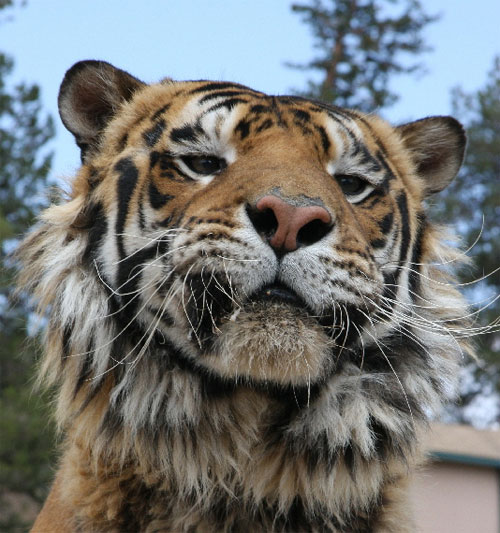
*This image is copyright of its original author
ShirkonShirkon is not just any Siberian Tiger either. Working with his trainer, Randy Miller, the first ever World Stunt Academy Award winner, Shirkon has entertained many of us over the years by performing in numerous movies, TV shows and documentaries (see sidebar).
In the weeks preceding Dr. Conrad’s evaluation of Shirkon, Randy had noticed that Shirkon was developing a gradual progressive weakness and loss of coordination. Shirkon was so weak he was having a hard time with even normal activities like eating. Dr. Conrad performed routine laboratory tests which failed to reveal a metabolic reason for Shirkon’s weakness. Following her initial evaluation, Dr. Conrad prescribed anti-inflammatory medications. While Shirkon responded transiently to the anti inflammatory medications Dr. Conrad had prescribed, his condition continued to deteriorate necessitating more information to guide his ongoing therapy.
Because of Shirkon’s shear size a traditional neurologic examination that relies on reflex hammers, bending joints and tapping tendons, would be challenging. The limited physical interaction possible with essentially wilds animals like Shirkon that just happen to have 3 inch long canine teeth and a bite force able to crush the largest human thigh bone would make a difficult physical evaluation impossible.
As a result it was not known if Shirkon’s symptoms originated from a problem in his brain or a problem in the spinal cord in his neck. As a result, Shirkon was potentially in need of two different MRI procedures. The first would evaluate his brain and middle ears. If that evaluation was negative for disease, a second MRI of the spinal cord in his neck would be needed. Managing the general anesthesia necessary to perform a diagnostic imaging procedure like an MRI is nothing unusual for Dr. Conrad, she routinely cares for patients that range in size from Shirkon’s massive weight to comparatively minute, pocket pets like mice. But Dr. Conrad needed a facility that could accommodate both Shirkon’s massive size as well as her need to limit his anesthesia time, despite the logistical hurdles that such a massive patient creates.
Dr. Conrad knew that many veterinary imaging facilities utilize miniaturized equipment either made to image small human body parts like knees and ankles. Alternatively other veterinary imaging facilities use more full sized equipment that is housed in cramped mobil trailers parked in the parking lot next to the veterinary facility. Shirkon’s shear size precluded the use of either of these options.
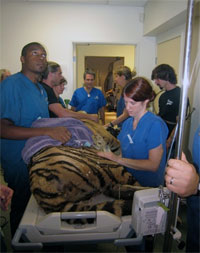
*This image is copyright of its original author
Inducing anesthesia in a patient of this size requires a coordinated effort.
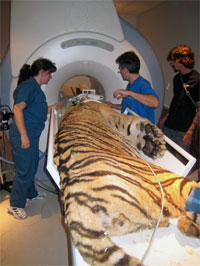
*This image is copyright of its original author
Moving a patient weighing over 400 pounds into the magnet room and positioning on the imaging table is another challenge
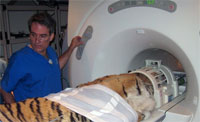
*This image is copyright of its original author
Once the preliminary work is done, the patient is ready for the imaging to begin.
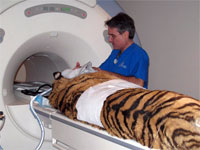
*This image is copyright of its original author
Finished with the scan, the process of moving this large cat out of the MRI suite remains a big job.
Strength Matters…
Strength is not just important in the wild kingdom. At least in the realm of Magnetic Resonance Imaging, the strength of the magnet is king. As it turns out the more powerful the magnet the quicker it can obtain the images. As a result, more and more powerful magnets are constantly being developed to allow a greater human patient throughput and ease human patient anxiety associated with the MRI procedure by shortening the procedure. And while shortening the time it takes to complete an MRI procedure is important in the human market, the ability to generate images quickly is even more important with veterinary patient’s who require the use of general anesthetics to immobilize them for the procedure.
The more powerful magnets have offer additional benefits as well including the ability to acquire thinner slices and image smaller anatomy. While these benefits would not be needed for a 425 pound tiger, they can be very useful when imaging the spinal cord of a 3 pound kitten or imaging the brain in a bald eagle. The diverse nature of veterinary patient size exceeds what most human diagnostic imaging centers encounter.
While very few veterinary facilities have MRI units installed within the physical walls of the building, even fewer have MRI units with sufficient magnetic field strength to ensure the optimal brief imaging times Dr. Conrad needed for Shirkon. Indeed AVMI is the only diagnostic imaging facility in southern California that has a super conducting, high field, 1.5 Tesla MRI scanner dedicated for veterinary use.
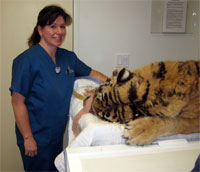
*This image is copyright of its original author
Following the procedure, Shirkon requires continued monitoring to ensure he has an uneventful recovery from anesthesia.
Experience matters…
In addition to equipment better than what is available in most human imaging facilities AVMI has the advantage of over 20 years of veterinary diagnostic imaging experience. Dr. Michael Broome began offering diagnostic nuclear medicine imaging procedures to southern California veterinary patients in 1986. Since that time, AVMI has expanded to provide additional diagnostic imaging modalities including CT and MRI.
Some veterinary diagnostic imaging centers are operated by individuals with limited experience interpreting veterinary specific imaging studies. This can lead to errors in the diagnosis or missed diagnoses. The presence of veterinarians experienced in diagnostic image interpretation on-site during the actual procedure allows for real time image interpretation. This ensures appropriate, on-the-fly, adjustments in the procedure can be performed to maximize the diagnostic value of the procedure as well as minimize the general anesthetic time to obtain that information.
In Shirkon’s case, it took only 10 minutes to determine that his brain was normal and not the cause of his weakness. Within less than an hour of imaging time the diagnosis of cervical intervertebral disc disease (i.e., a bulging disc in his neck) was made and Shirkon was on his way to recovery. Now all that was left is for surgery to be scheduled for another day.
http://www.avmi.net/success-stories/size-matters-tiger-mri/
RE: Captive Lion and Tiger weights - GrizzlyClaws - 11-04-2016
Shirkon looks like having a little of Sumatran in him.
RE: Captive Lion and Tiger weights - Kingtheropod - 11-04-2016
(11-04-2016, 02:26 AM)GrizzlyClaws Wrote: Shirkon looks like having a little of Sumatran in him.
I agree, possibly mixed with Bengal too. His facial characteristics are not that of a typical Amur tiger.
He is also very thin. And so are a lot of the tigers shown above. My guess is that if they where in normal condition, they would each weigh about 10% heavier.
BTW, Pckts, can you find out which zoos those tigers came from?